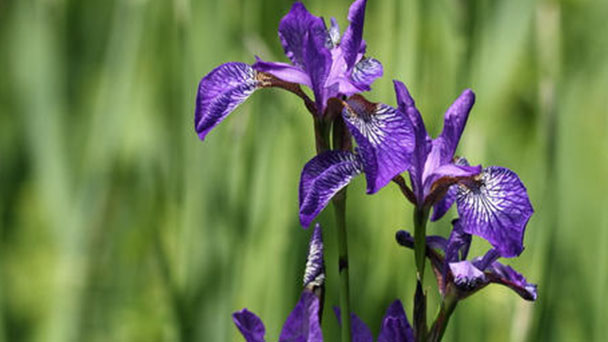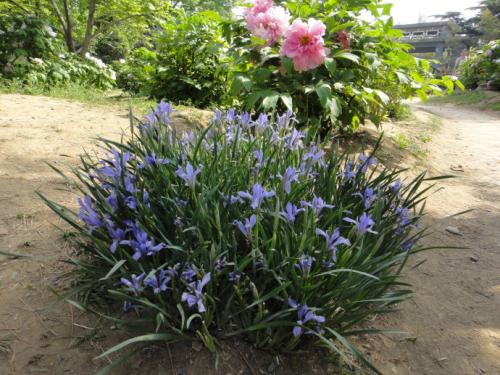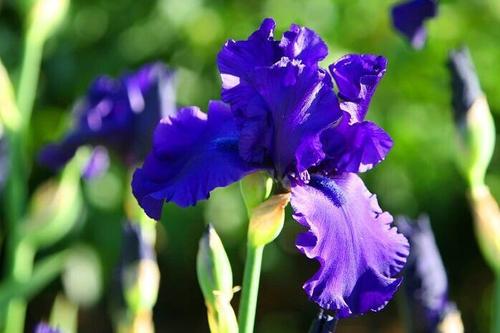Siberian iris (Iris siberica) profile
Written by Maggie
Apr 20 2021

Siberian iris (Iris siberica) is a perennial herb, native to Europe. Siberian iris is often planted in gardens and flower beds for ornamental.
Siberian iris picture

Siberian iris info
| Botanical Name | Iris siberica |
| Common Names | Siberian iris |
| Plant Type | Herbaceous perennial |
| Sun | Full sun to partial shade |
| Hardiness Zones | 3 to 9 |
| Flower color | Blue, violet, white, or purple |
| Native Area | Northern Asia |
| Mature size | 3 to 4 feet tall, with a spread of 2.5 to 3 feet |
Morphological characteristics of Siberian iris
Siberian iris is a perennial herb surrounded by sheathed leaves at the base and fibrous remnants of old leaves. Rhizome is stout, obliquely extended; The fibrous roots are yellow and white, cordaceous, with a wrinkled horizontal stripe. Leaves are grayish green, striped, 20-40 cm long and 0.5-1 cm wide, apically acuminate, without obvious midvein.
Siberian iris has 3 bracts, membranous, green, margin reddish purple, narrowly ovate or lanceolate, 4 -- 5.5 x 0.8 -- 2 cm, apex shortly acuminate, containing 2 flowers; Flowers are blue-purple, 7.5-9 cm in diameter; Pedicels are very short; Perianth tubes ca. are 1 cm long, outer perianth lobes obovate, 5.5 -- 7 cm long, 3.3 -- 5 cm wide, reflexively pendulous, broadly cuneate, central indentation furrowed, with brown reticulate and yellow markings, without appendages, inner perianth lobes narrowly elliptic or oblanceolate, 4.5 -- 5.5 cm long, 1.5 -- 1.8 cm wide, erect; Stamens of Siberian iris are 3-3.5 cm long, anthers purple, filaments lavender; Style branches are pale blue, arched, 4 -- 4.5 cm long, apex lobes sub semicircular, margin irregularly-sparsely dentate, ovary green, fusiform, 1.5 -- 2 cm long.
Capsule of Siberian iris is ovate-cylindrical, long cylindrical, or ellipsoid-columnar, 3.5 -- 5.5 cm long, 1.3 -- 1.5 cm in diameter, beakless.
Siberian iris growth habit
Siberian Iris is both cold and heat resistant, and can grow well in shallow water, wetlands, shade trees, dry land or pot plants. Besides, it has strong disease resistance, especially resistance to root rot. It is a kind of highly adaptable iris.
The distribution of Siberian iris
Siberian iris is originally in Europe. Siberian iris is often planted in the garden and flower beds for viewing, now the world can be cultivated in many places.
Siberian iris propagation
The propagation of Siberian iris is usually by division propagation, sowing propagation, rarely by cutting propagation.
Division
Siberian iris division takes place in spring and fall. Dig out the breeding mother from the cultivation soil, minimize the damage to the root system, shake off the soil, lay it on the board, divide it into individual plants with a sharp knife, ensure that each Siberian iris has fibrous roots, in order to improve the survival rate. Then the plants will be planted into the pot in a timely manner, pay attention to the soil should be flush with the rhizomes, so as to ensure good plant growth, easy germination of new plants, but also to prevent the shallow root system, poor development and lodgings.Water thoroughly after planting, make sure the soil in the basin is thoroughly watered and water runs out of the drain. Then placed in the natural light, without shading, about 20 days can give birth to new roots.
Sow
In autumn, when the seeds of the Siberian iris are mature, they should be sown in time, as picking and sowing will help to increase the germination rate. Before sowing, the whole seeding bed will be irrigated permeably, and then peel the seed from the fruit, according to the bed soil, depth in order to bury the seed is appropriate. Then covered with a little soil, after watering the cover film, and maintaining a certain temperature, under the condition of 25℃, a month can emerge.
Cuttings
Siberian iris cutting propagation usually uses lower scape with leaf cuttings, but the propagation coefficient is low, cutting seedling growth is weak, so rarely used.

How to grow and care for Siberian iris
Moisture
Siberian iris has wet resistance, in the small seedling stage, the water demand is small, especially when the temperature is low, such as soil moisture content is too large, is not conducive to the growth and development of plants;When the temperature rises, the Siberian iris enters vigorous growth, requiring more water, and can grow in water up to 30 cm deep. The soil must be watered before planting and kept moist during planting to promote rapid rooting. The soil should also be kept moist after planting the balls. After that, the soil must be sufficiently wet for a long period of time throughout the growing period. Appropriate humidity is very important for the growth of irises, because the lack of humidity will indicate that the growth height of the plant is not enough, and the flowers are prone to wither.
The amount of irrigation cannot be accurately calculated because it depends on many factors, such as weather, greenhouse climate, soil type, crop cycle and stage of growth. One of the easiest ways to determine if the soil moisture is right is to take a small amount of soil and hold it in your hand. When you release it, the soil will remain in place and the moisture will be just right. It is better to water in the morning. Water the Siberian iris in the morning. The plants will dry differently. Water the plants after picking the flowers during harvest, or the flowers will appear gray mold spots. It is best to use water uniform top spray when irrigation.
Humidity
The ideal relative humidity is between 75-80%. It is important to take care to avoid large or gradual changes in humidity. Relative humidity tends to be high on warm sunny, shady or humid days. Corresponding measures must be taken to reduce humidity through simultaneous heating and ventilation.
The temperature
The lowest and highest temperatures for open-air cultivation were 5℃ and 25℃. The soil temperature should be kept the same as when the greenhouse was growing. Siberian iris grows fastest at 25-30℃, and grows slowly at about 0℃. It is generally cultivated on open ground. Ventilation is a very important means to control temperature and reduce humidity. When ventilating, we should pay attention to the humidity and can not fall too fast, otherwise the leaves will wither, resulting in the decline of the quality of cut flowers. The constant heat of the day can be shaded out by shading nets. Not only does it reduce direct solar radiation, but it also raises the temperature.
Light
Siberian iris loves the light and grows well in strong light. Shading devices control the temperature, humidity and light in the greenhouse. Shading and ventilation can inhibit the decline in cut flower quality in the highlight months when the ventilated greenhouse and open field temperatures are too high (above 25 ° C).
Soil
Siberian iris grows in all kinds of soils but grows best in rich loam soil. In heavy loam, it is recommended to add such as peat, vermiculite or coarse sand to a depth of about 25 cm to improve the soil. Soil that is easy to solidify. After planting, cover the soil with a layer of material such as rice husks, straw, pine needles, black peat, or similar to prevent the soil from solidifying. Sub-methods may also be used to prevent the soil from drying out too quickly. In order to make excessive moisture should be quickly removed, it should be configured with a good drainage system. This also makes it possible to use water to leach greenhouse soil. This treatment can prevent the accumulation of salt problems caused by the use of less water during the planting of fertilizer crops or during certain planting stages.
Fertilizer
To promote the seedling fast growth, but every 10 days combined with watering application of a small amount of urea, in the scape out can be applied a compound fertilizer, in order to promote flowering, extend flowering period.In general, applying basal fertilizer before planting is not advisable, because it will increase the concentration of salt in the soil and delay the root growth of Iris. Sample the soil before planting to make sure it contains the correct nutrients. Sampling must be done after the soil has been treated and washed. In this way, the missing nutrients can be obtained by replenishing the soil directly later. Siberian iris is sensitive to fluorine, therefore, fluorine fertilizer (phosphate fertilizer) and triphosphate fertilizer are prohibited. On the contrary, bisphosphonate fertilizer should be used.
Weeding
The growth process of Siberian iris only takes 8-12 weeks. In such a short growth period, if the soil is treated by steaming, flooding and plowing, weeding is not necessary to be considered in the growth process of the plant. After the plants are planted, chemical herbicides are used mainly to remove weeds. But be careful not to cause damage to the plants when applied.
If weeds start to grow in the ground after the Siberian iris has been planted, the herbicide should only be applied when the balls are buried deep enough. The new buds are protected from herbicides at least two centimeters below the soil.
Greenhouse or open grass can be controlled by spraying a suitable herbicide before the Siberian iris develops its leaves. If common herbicides are not effective in controlling some annual grass weeds, compound herbicides should be used instead. Apply when it is late in the day. Spray the Siberian iris with plenty of water. The next morning, rinse thoroughly from the top of the plant. Since herbicides have residues, the following points must be noted. The amount of herbicide applied to each field in a year should be limited to no more than 2 times. Use herbicides only when necessary.
Siberian iris varieties
In terms of size and shape, the different varieties of Siberian iris do not diverge greatly from each other. But hardiness does vary, and you have a choice between three or four flower colors.
'Caesar's Brother': Purple flowers; zones 3 to 8
'Snow Queen': White and yellow flowers; zones 5 to 8
'Butter and Sugar': White and yellow flowers; zones 3 to 8
Siberian iris ornamental value
Siberian iris has a wide range of applications. It can be planted in the corner of pools and rockery, and also in wetlands and forests. It is also a popular garden plant for potted ornamental effect.

Latest Updated
- Benefits of Bugleweed - 7 Science-backed Health Benefits
- Bugleweed Dangers & Side Effects - Is It Poisonous?
- How to Plant Evergreen Trees - What You Should Know
- When to Plant Evergreens - Grow Guide for Evergreen Trees
- 12 Wonderful Evergreen Shrubs for Your Garden
- 12 Popular Evergreen Plants with Pictures for Beginners
- When And How To Prune A Lilac Bush Like a Pro
- How to Grow & Care for Lilac Vine (Hardenbergia Violacea)
- Japanese Lilac Tree (Syringa Reticulata) Care & Propagation Guide
- Shumard Oak Pros and Cons - What to Know
Popular Articles
- Winter maintenance of Antirrhinum Majus
- How to Grow Terminalia Mantaly Tree
- How to Grow and Care for Crossostephium Chinense
- How to grow Antirrhinum Majus in spring
- Peristeria Elata (Dove Orchid) Profile: Info & Care Guide
- Underwatered Snake Plant (Sansevieria Trifasciata) - Signs And How To Fix
- How to Care for Brazilian Jasmine Plant (Mandevilla Sanderi)
- How to Grow & Care for Graptopetalum Purple Delight in Summer
- Rosa Chinensis (China Rose): Plant Growing & Care Tips
- How to Care for Baby Sun Rose (Aptenia Cordifolia)